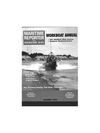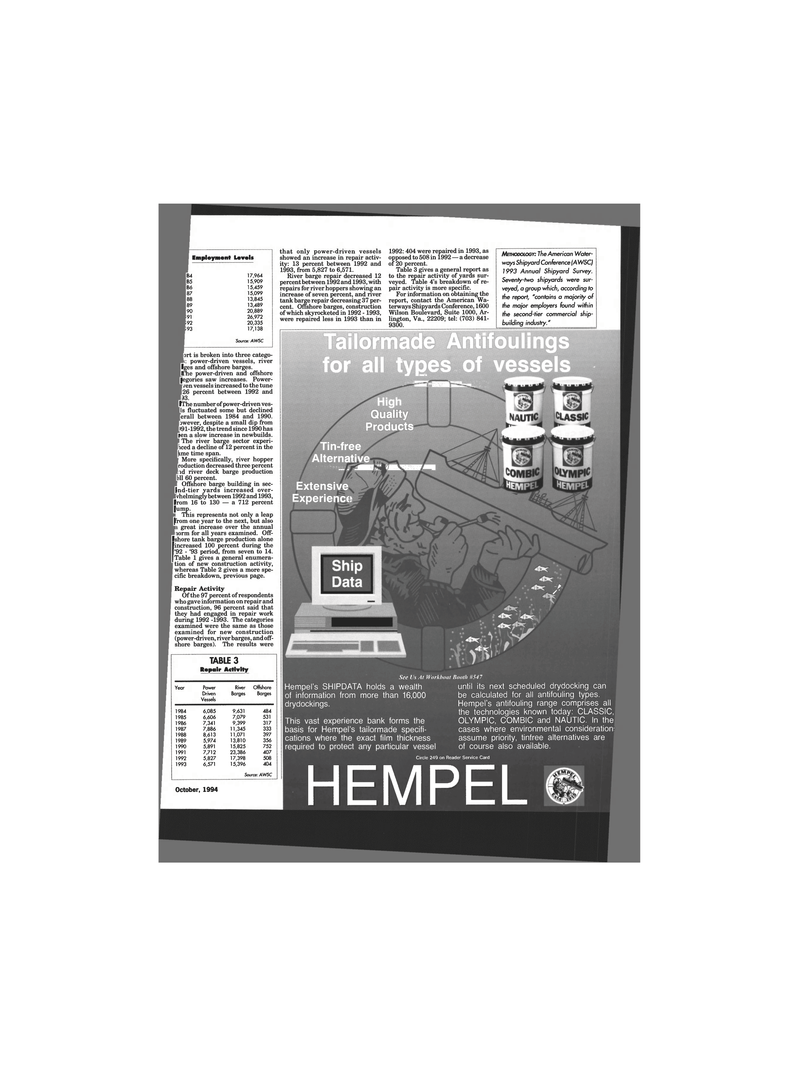
Page 86: of Maritime Reporter Magazine (October 1994)
Read this page in Pdf, Flash or Html5 edition of October 1994 Maritime Reporter Magazine
Extensive
Experience
Employment Levels
B4 17,964
B5 15,909
B6 15,459 8 7 15,099 88 13,845 89 13,489 90 20,889 91 26,972 92 20,335 93 17,138
Source: AWSC
TABLE 3
Repair Activity
Year Power River Offshore
Driven Barges Barges
Vessels 1984 6,085 9,631 484 1985 6,606 7,079 531 1986 7,341 9,399 317 1987 7,886 11,345 333 1988 8,613 11,071 397 1989 5,974 13,810 356 1990 5,891 15,825 752 1991 7,712 23,386 407 1992 5,827 17,398 508 1993 6,571 15,396 404
Source: AWSC
October, 1994 that only power-driven vessels showed an increase in repair activ- ity: 13 percent between 1992 and 1993, from 5,827 to 6,571.
River barge repair decreased 12 percent between 1992 and 1993, with repairs for river hoppers showing an increase of seven percent, and river tank barge repair decreasing 37 per- cent. Offshore barges, construction of which skyrocketed in 1992 -1993, were repaired less in 1993 than in 1992: 404 were repaired in 1993, as opposed to 508 in 1992 — a decrease of 20 percent.
Table 3 gives a general report as to the repair activity of yards sur- veyed. Table 4's breakdown of re- pair activity is more specific.
For information on obtaining the report, contact the American Wa- terways Shipyards Conference, 1600
Wilson Boulevard, Suite 1000, Ar- lington, Va., 22209; tel: (703) 841- 9300.
METHODOLOGY: The American Water- ways Shipyard Conference (AWSC) 1993 Annual Shipyard Survey.
Seventy-two shipyards were sur- veyed, a group which, according to the report, "contains a majority of the major employers found within the second-tier commercial ship- building industry." art is broken into three catego- power-driven vessels, river
Iges and offshore barges.
The power-driven and offshore |egories saw increases. Power- /en vessels increased to the tune 26 percent between 1992 and }3. iThe number of power-driven ves- ts fluctuated some but declined erall between 1984 and 1990. ywever, despite a small dip from 191-1992, the trend since 1990 has ten a slow increase in newbuilds.
The river barge sector experi- iced a decline of 12 percent in the fime time span.
More specifically, river hopper roduction decreased three percent id river deck barge production bll 60 percent.
Offshore barge building in sec-
Jnd-tier yards increased over- whelmingly between 1992 and 1993,
Irom 16 to 130 — a 712 percent |ump.
This represents not only a leap |From one year to the next, but also great increase over the annual lorm for all years examined. Off-
Ishore tank barge production alone [increased 100 percent during the |'92 - '93 period, from seven to 14. [Table 1 gives a general enumera- tion of new construction activity, whereas Table 2 gives a more spe- cific breakdown, previous page.
Repair Activity
Of the 97 percent of respondents who gave information on repair and construction, 96 percent said that they had engaged in repair work during 1992 -1993. The categories examined were the same as those examined for new construction (power-driven, river barges, and off- shore barges). The results were
Tailormade Antifoulings for all types of vessels !9I OR MB H - 1 fr
Quality
Products
Tin-free
Alternative HM^RBhV Jrv^l^^B fl| /
See Us At Workboat Booth #547
Hempel's SHIPDATA holds a wealth of information from more than 16,000 drydockings.
This vast experience bank forms the basis for Hempel's tailormade specifi- cations where the exact film thickness required to protect any particular vessel until its next scheduled drydocking can be calculated for all antifouling types.
Hempel's antifouling range comprises all the technologies known today: CLASSIC,
OLYMPIC, COMBIC and NAUTIC. In the cases where environmental consideration: assume priority, tinfree alternatives are of course also available.
Circle 249 on Reader Service Card HEMPEL

 85
85

 87
87
